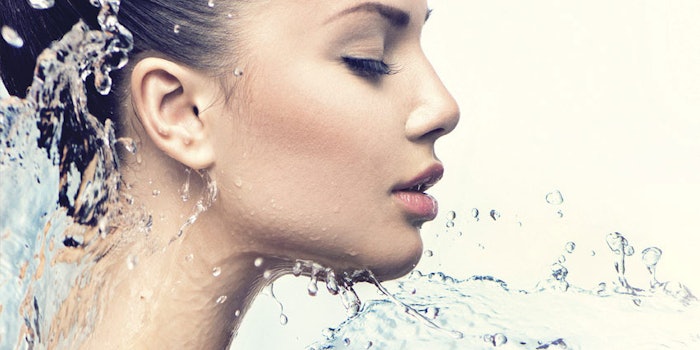
One of the most important attributes for skin is hydration, no matter what time of year. While the colder, drier winter months make moisturization needs more obvious, being properly hydrated is a must year-round. Understanding how the skin functions, as well as adopting therapies to introduce and lock moisture into the skin, will help you and your clients achieve balanced, hydrated skin throughout the seasons.
Optimally Functioning Skin
Where moisture is concerned, the stratum corneum (SC) plays an essential role in the function, health and maintenance of skin. The SC structure is often described as a wall of brick and mortar, where the bricks are dead skin cells (corneocytes) that contain a complex combination of lactic acid, urea, salts and amino acids, collectively referred to as the skin’s natural moisturizing factor (NMF). The mortar is made up of ceramides, cholesterol and free fatty acids that organize themselves into layers, creating a natural water-binding barrier for the skin. If there is a breakdown in either the bricks or mortar, skin loses its ability to hold onto moisture.
As part of skin’s “mortar,” ceramides are natural lipids that hold skin cells together. They are essential for moisturized skin; without them, skin becomes dry, irritated and sensitive. When the overall balance of the epidermis is thrown off, an increase of trans-epidermal water loss (TEWL) can result, leading to inflammation and, with additional UV exposure assaulting unprotected skin, a collapse of the extracellular matrix (ECM). The natural desquamation process, during which dead skin cells are sloughed off, is interrupted without enough moisture. Over time, this lack of moisture and UV damage, as well as a buildup of dead skin cells, will result in dry and flaky skin, wrinkling, laxity and an overall aged appearance. An excess of dead cells on the skin’s surface traps dirt and debris, and reduces the penetration of any topical products applied to skin. This creates an even worse situation for already stressed and dehydrated skin.
It is only with proper hydration in the form of adequate water intake, topical daily care products and professional treatments that balance in skin is achieved, assuring that the largest organ in the body is performing optimally.
Water- and Oil-Based Hydration
One of the primary ways to stay moisturized is to hydrate from the inside out. Proper water consumption each and every day has an immense impact on the health of skin. Without enough water, the skin will present decreased elasticity, dryness and an inability to properly regenerate itself. Without the continuous shedding of dead skin cells, inflammation, acne and an overall dull appearance will result.
Additionally, hydrating agents that help seal water into the skin, as well as beneficial oils, are essential for proper moisturization. While many clients associate oil with breakouts and acne, there are many advantages to using oils in skin care, so including them in daily care regimens aids in the proliferation of healthy skin. Without a balance of oils, we may begin to actually over-produce oil from our glands, which can lead to those unwanted breakouts.
Humectants and Occlusives
To find the best topically moisturizing ingredients to use on your clients, it’s important to consider how these ingredients work in the skin. Whether the ingredient is a humectant or occlusive will determine if it’s attracting moisture or locking it in, respectively; both are necessary for successful skin hydration.
Humectants. These ingredients attract water and pull it into the epidermis from the dermis. Some popular, effective humectants include the following.
- Glycerin and urea provide surface hydration in addition to infusing skin cells with moisture directly.
- Sodium PCA can attract and hold up to 250 times its weight in water.
- Lactic acid is hydrophilic and breaks down skin desmosomes for exfoliation ease. In addition, it is
an antibacterial ingredient that inhibits the formation of hyperpigmentation caused by UV rays. - Hyaluronic acid and sodium hyaluronate are among the strongest humectants that attract and hold up to 1,000 times their weight in water.
Occlusives. On the other hand, occlusives lock the moisture that humectants attract into the skin. Products that contain them are often best to use post-bathing, to seal in moisture while the pores of the epidermis are open.
Many occlusives can be too emollient and are best avoided in acne-prone clients, especially on the face; these include petrolatum, mineral oil and lanolin—which is also a common allergen for many people.
Note that occlusive agents do not necessarily provide added benefits to skin; they simply remain on the surface to hold moisture in. However, following are some occlusive agents that also provide skin benefits.
- Sweet almond oil contains the antioxidant and anti- inflammatory vitamin E.
- Jojoba oil closely mimics sebum, reducing the occurrence of excess sebum.
- Shea butter is beneficial for dry skin, keeping it soft and maintaining moisture levels without feeling greasy. It is high in triglycerides, EFAs, and vitamins A and E.
- Niacinamide reduces the occurrence of breakouts, increases ceramide and EFA levels, and maintains hydration, reducing TEWL.
- Zinc oxide provides broad-spectrum UV protection while reducing inflammation and inhibiting the formation of hyperpigmentation.
Interestingly, some ingredients that are primarily thought to be humectants, such as hyaluronic acid, provide occlusive benefits simply due to their large molecular size. They tend to sit on the skin surface to draw moisture into the epidermis and also create a physical barrier to TEWL.
In addition to moisturizers that contain the humectants and occlusives listed, advise clients to use hydrating serums. This is especially important in drier winter months and during summer when increased time periods of UV exposure take a toll on skin moisture.
Daily Care
Since the daily use of beneficial moisturizing ingredients is a must to ensure proper hydration, there are additional measures to be taken in the course of a daily skin care regimen that will help avoid moisture imbalance.
Wash gently. Educate patients on the importance of not over-washing their skin with harsh cleansers or aggressive exfoliants, which can lead to the production of excess sebum and acne breakouts. Instead, they should use pH-balanced, gentle cleansers.
Harness oils. Make sure your breakout-prone patients understand that oils containing EFAs are beneficial to their condition; oil-free is not always best and can also make their condition worse.
Use sunscreen. Recommend the best broad-spectrum sunscreen with an SPF of at least 30 for individual patients’ skin types and conditions, and assure they are applying it properly daily. UV damage can dry out the skin and worsen the skin concerns for which they’ve come to you for treatment.
To be sure, this last point can’t be spoken about enough. Unprotected exposure to UV rays can lead to inflammation, burning and peeling that destabilizes the skin’s moisture retention mechanisms, leading to dehydration as well as skin damage and even skin cancer. Advise patients to choose a sunscreen that contains antioxidants to help lessen the potential for that damage. Ingredients to highlight include: L-ascorbic acid, tocopherol, caffeine and milk thistle-derived silybin.
Also, make sure patients are applying their SPF at least 15 minutes before leaving the house and reapplying every two hours to avoid any negative UV impact on unprotected skin. This is a must, regardless of the given month. While many assume UV exposure is higher in the summer, UVA rays are constant throughout the year. Weather plays a factor as well, with snow reflecting up to 80% of UV rays, while sand reflects 15% and water only 10%. Helping patients understand these truths will assist in more diligent sunscreen use year-round.
Professional Treatments
While utilizing moisturizing ingredients in daily care is of utmost importance, the skin care professional is an important part of maintaining hydration. Advanced levels of moisture can be infused into your patients’ skin through monthly treatments via chemical peels and professional masks. These treatments will help remove any impacted skin cells to further improve the skin’s ability to absorb hydrating topical ingredients in daily care products.
Chemical peels and masks should include hydrating and exfoliating ingredients, including the following:
- Lactic acid, which increases hydration;
- Chasteberry extract, a phytohormone derived from plants that hydrates and plumps the skin;
- Soy isoflavones, which contain antioxidants to boost collagen and improve the appearance of aging skin;
- Oat milk, a humectant with antioxidant protection that adds high levels of EFAs; and
- Panthenol, glycerin and sodium hyaluronate, which have hydrating properties for all skin conditions including acne, rosacea and aging skin.
Be Diligent
By following these strategies and therapies for proper moisturization, your clients will enjoy healthy, luminous skin daily and continuously, no matter what the thermometer reads.











